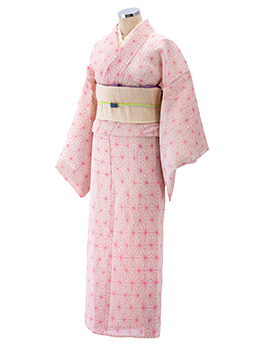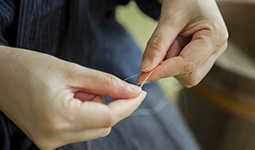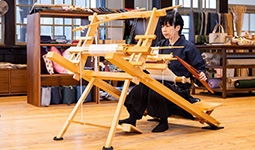INDEX
- English
- 日本語

Samples of kibira, Omi jofu fabric - English
- 日本語

Samples of kasuri, Omi jofu fabric

An Omi jofu kimono for summer 
Teumi, the process of making thread by hand 
Weaving kasuri fabrics requires great attention to detail
August 2021
Handmade Hemp and Ramie Fabrics Fit for the Summer Heat

The Koto region of Shiga Prefecture to the east of Lake Biwa, the largest lake in Japan, has been a production center for certain plant-based fabrics for over 600 years. Today, while keeping true to traditional techniques, the region is working not only on kimono but also on products with new applications that combine quality and design.

Fabrics made from hemp, jute, ramie and linen are collectively known in Japan as asa (hemp) orimono, and high-quality asa orimono is called jofu. Having superior absorbency and wicking, these plant-based fabrics easily release heat and moisture from the body. They also have firmer fibers compared to cotton or silk so are highly breathable. With their light-feeling texture, they are ideal fabrics for summer clothing.
Linen, the most popular plant-based fabric today, was introduced to Japan in the Meiji period (1868–1912). Before then, hemp and ramie, different types of plant-based fabrics, were used in Japan. In particular, hemp was sacred and used for religious rituals since ancient times, such as for ropes that indicated a sacred place where gods descended or for ornamental aprons worn by sumo grand champions. The fibers are torn, twisted into thread, and the yarn is spun by connecting one thread to another, but as the fibers are short, this is extremely time-consuming.

The Koto region of Shiga Prefecture, which has been well-known as a region of production for hemp- and ramie-based fabrics since the Muromachi period (1336–1573), continues to offer its special locally-made Omi jofu fabrics, products created by hand using techniques that have hardly changed over their roughly 600-year history. Omi jofu, which has been designated as a traditional craft product by the Japanese government, consists of two varieties: kasuri and kibira. Kasuri is fabric made with ramie threads that have been colored using a stencil dyeing technique to create kasuri patterns in the fabric when woven together. A wrinkled texture is sometimes introduced to the surface of kasuri by kneading the woven fabric. Kibira is a plain weave fabric that uses ramie for the warp and teumi hemp for the weft. Teumi refers to the process of tearing the hemp by hand to create very fine fibers and then twisting them together to form threads. It is a time-consuming process. Compared to ramie, hemp fibers are coarse and rigid, and hemp was often used for agricultural work clothing in the past, but in the Koto region, with great technical finesse, hemp was made into a soft, high-quality fabric that could be used for kimono and a variety of other purposes.
Tanaka Yumiko from the Omi Jofu Traditional Crafts Center says, “In other plant-based fabric production areas, these fabrics were made using ramie, which is easy to handle, but in the Koto region, textile makers ambitiously used hemp, which is crude as a fabric. And so kibira was born with a texture not inferior to ramie and, together with ramie kasuri, the Omi jofu brand was established.

“Kibira, which is finely woven using delicately spun thread, has a softer texture than linen. Once, when a person from a country in east Asia touched fabric from the Koto region, they told me that they didn’t know a material with a texture that felt so nice. I think this shows just how high the quality of the fabric is. With kasuri, a gap is formed between the fabric and the skin because the woven fabric has been shrunk through a process of rubbing it by hand. Because there is little surface area that touches the skin, it is extremely cool and, with its smooth texture, I think it is just right to wear during the hot and humid Japanese summers.”
However, fewer time-consuming-to-create hemp- and ramie-based fabrics are now found in the marketplace. Currently, 80 to 90% of plant-based fabrics in Japan are linen and less than 10% are ramie, and after that hemp accounts for only a few percent.

“Because the yarn is carefully spun with only quality materials, only 5 to 10 grams of kibira thread can be made in a day,” Tanaka says. “It takes about two to three months just to create enough thread for an obi for kimono and it can take about six months to finish the obi. This means that the price of one obi is very high (roughly 9,000 USD). This isn’t something that sells easily, but there are some customers who want these products even if it takes a long time to make. This is all that is left today of this tradition of creating and selling products made using hemp gathered in Japan.
“Somehow, we will pass on Omi jofu, with its ability to offer a sense of cool in the summer, and not let it disappear.”
Taking on this task, the Omi Jofu Traditional Crafts Center works to train weavers while also working to develop masks, towels, aprons, headbands, and other products that match modern lifestyles using modern machine-woven fabrics for the promotion of fabric manufacturing, a traditional industry. These products are made with an emphasis on design, and increase the value of Omi jofu.


